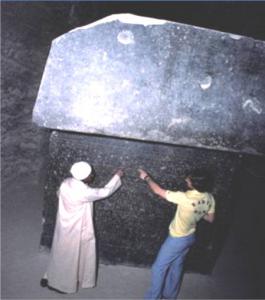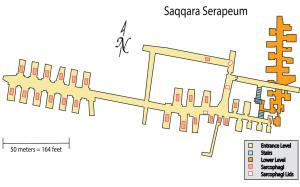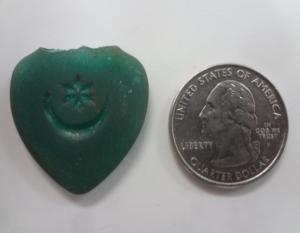Radioactive Materials in Ancient Egypt
Did the Ancient Egyptians have knowledge of Radioactivity and its uses?
In 1978, James Brown and his team explored the elaborate tunnel system that is large enough to accommodate semi-trucks. Brown recorded heavy encrustations of salt on the walls and ceilings through mineral analysis in this complex that verified water came from the Nile River in ancient times. In 1980, Brown contacted an engineering professor at UCLA to understand how to make a huge, rectangular granite box cut out of a solid block of granite with a matching lid. In the professor’s opinion, while we could get close today, we would not be as precise. The professor said the interior corners were perfectly square while modern interior corners are slightly rounded.
On June 8, 1978, the following headline appeared in the Palm Springs, California Desert Sun, “Radioactive storage studied: Granite Caverns Eyed.” James Brown had recently returned from his research trip to Egypt and was amazed to see this news in his local newspaper. The article described how the US was spending five million dollars on a joint venture with Sweden to study the possibility of storing radioactive material in underground granite caves filled with salt water. Modern industrial processing vats are lined with granite panels and can contain extremely volatile chemical reactions and store caustic substances such as sulfuric acid, hydrochloric acid, nitric acid, bromine, and other volatile substances. Ancient Egyptian and modern methods show amazing similarities. Could giant granite boxes in ancient Egypt have been used in ancient times to store radioactive or toxic materials?
During the same 1978 research trip, Brown obtained a very unusual amulet. His guide introduced him to an Egyptian farmer. As the farmer plowed his field in the old-fashioned way, he occasionally uncovered objects that had been buried for thousands of years--mostly small amulets, scarabs, tiny vases or small bronze statues and beads. Brown admired one item in particular, a small, heart-shaped amulet the color of aquamarine. At that time the amulet had a hole in the top to accommodate a chain; it has since broken off. Brown left Egypt with the aquamarine amulet tucked in his pocket and had a jeweler add a gold wire so he could wear it as a constant reminder of his Egyptian journey.
About the same time, he acquired a Geiger counter, a device that measures ionizing radiation in the background. Everything gives off some level of radiation. Using his new device Brown measured the background radiation of the family TV, the kitchen microwave and radios. Most attempts to get a reaction from household appliances showed no measureable results. However, when Brown walked down the hallway of his home, carrying the Geiger counter, the wand happened to brush across his chest and the needle jumped on the display. He moved the wand toward his chest and the needle jumped again. Brown realized the amulet he wore caused the Geiger counter needle to jump. He immediately removed the amulet.
What method, more than three millennia ago, could have formed this attractive amulet, and what would have been its purpose? Brown continually checked the radioactive background count of the amulet, which was consistently four to five times higher than the normal radioactive background count. In 1979 Brown’s colleague Dr. J.J. Hurtak had the amulet privately analyzed by engineers who had worked at NASA (JPL). The results showed the amulet was 3,200 years old. The radioactive readings were between 85 and 90 CPM with a blue-green glow that suggested strong radioactivity was still present after thousands of years. The physical analysis showed that it was manmade glass with radioactive particles suspended inside. The scientists who tested the pendant were baffled.
James Brown and his son Cayce visited the Serapeum again in March 2018. The site looks vastly different from 1978 since the recent massive restoration project. Brown noticed that the heavy encrustations of salt were gone, and the crumbling ceilings were reinforced with heavy metal braces. A wooden floor made walking easier and reduced dust. The 80-ton granite boxes were in the same locations.
Brown made a surprising discovery during this visit. Having suspected that these granite boxes had something to do with storing volatile materials or radioactive substances, Brown brought along his Geiger counter. The radioactive background count in the corridors, about 100 feet away from one of the granite boxes, was about 14 bursts per minute. The measurement inside the box were about 38 bursts per minute, almost three times as high as normal.
We are becoming increasingly aware that the ancient Egyptians used knowledge we have yet to rediscover. Brown believes the extremely unusual granite vessels should be investigated as possible toxic storage containers or as a power supply since the Serapeum is connected underground to the Step Pyramid. The granite boxes could have been electricity-generating batteries that powered the Step Pyramid. Granite emits some amount of radiation, but 38 bursts per minute seems excessive. Brown explores these ideas in his award-winning book Giza’s Industrial Complex: Ancient Egypt’s Electrical Power & Gas Generating Systems.
James E Brown
Ancient Energy Research Center
+1 970-731-3071
email us here
Legal Disclaimer:
EIN Presswire provides this news content "as is" without warranty of any kind. We do not accept any responsibility or liability for the accuracy, content, images, videos, licenses, completeness, legality, or reliability of the information contained in this article. If you have any complaints or copyright issues related to this article, kindly contact the author above.



